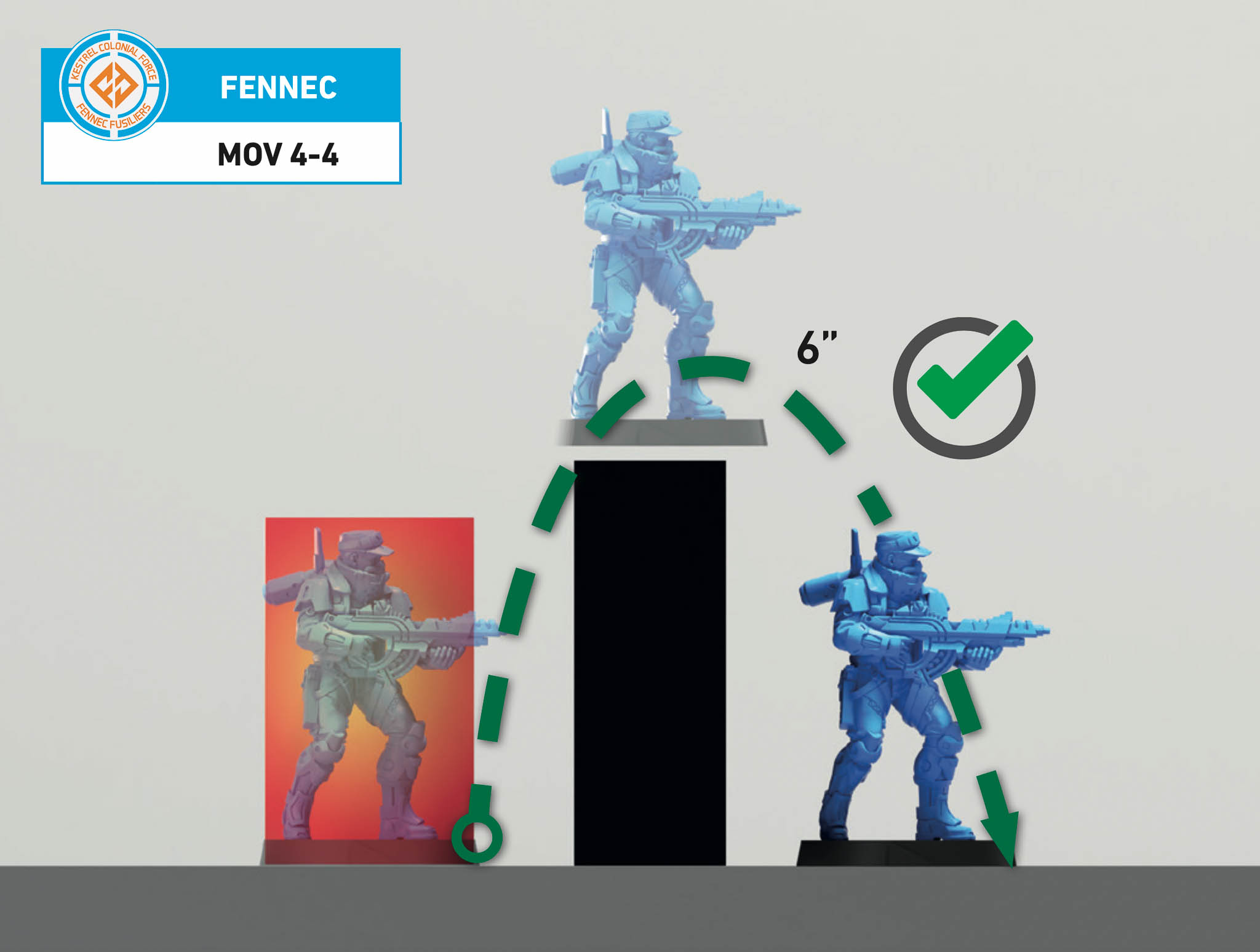NOTICE: Infinity N5.2 and N5 FAQ 0.0.0
The wiki has been updated to include the N5.2 changes and the v0.0.0 FAQ.
List of wiki pages updated in N5.2.
Difference between revisions of "Jump"
m |
(N5 first version.) |
||
| Line 1: | Line 1: | ||
| − | {{section-movement-module}} | + | {{n5-section-movement-module}} |
| − | {{section-common-skills}} | + | {{n5-section-common-skills}} |
| + | This Common Skill allows the user to clear obstacles and leap over small distances. | ||
| − | + | {{css_skillbox |red| JUMP | LONG SKILL }} | |
| + | {{skill-label | Movement, No LoF, No Roll. }} | ||
| + | {{requirements}} | ||
| + | Players must check the Requirements of this Skill when declaring it. | ||
| + | * The Trooper must be able to reach a horizontal landing spot, which must be equal to or larger than the Trooper's base. | ||
| − | {{ | + | {{effects}} |
| − | + | * Allows the user to move horizontally, vertically, diagonally or tracing a parabola, without changing their heading. The user can Jump up to the first value of their MOV [[Attribute]], plus 2 inches. | |
| − | |||
| − | |||
| − | |||
| − | |||
| − | |||
| − | * Allows the user to move horizontally | ||
* Jump is a Common Skill that does not require a Roll. | * Jump is a Common Skill that does not require a Roll. | ||
| − | * When Jumping, measure the horizontal, vertical, diagonal or parabolic distance between the starting location | + | * When Jumping, measure the horizontal, vertical, diagonal or parabolic distance between the starting location '''and the landing spot''', measuring from the base's outer edge and underside. |
| − | * Troopers cannot benefit from | + | * A jump ends when the Trooper touches a surface, which will be the landing spot. |
| − | * Jumping movement must follow the [[General Movement Rules]] as well as the [[Moving and Measuring]] rules. | + | * Troopers cannot benefit from [[Partial Cover]] MODs during an Order in which they declared Jump. |
| − | + | * Jumping movement must follow the [[General Movement Rules]] as well as the [[Moving and Measuring]] rules. | |
| − | * | + | * Some Troopers have the Jump Skill listed in their Unit Profile with a distance shown in round brackets. When Jumping, the Trooper can add this distance to their Jump, instead of 2 inches. |
| − | + | * Declaring Jump automatically cancels [[Prone State]]. | |
| − | + | {{css_skillbox-end}} | |
| − | * | ||
| − | |||
{{explain-start}} | {{explain-start}} | ||
| − | Measuring parabolas: | + | Measuring parabolas: The easiest way to measure a parabolic route is using a flexible measuring tape, bending it for convenience. |
| + | |||
| + | Before the game begins, it is a good idea for both players to agree on which surfaces on the game table will require the use of the Jump Skill, taking into account potentially dubious cases. | ||
{{explain-end}} | {{explain-end}} | ||
| Line 32: | Line 31: | ||
== Examples == | == Examples == | ||
{{greybox-start | Example 1 }} | {{greybox-start | Example 1 }} | ||
| − | + | {{image | name=n5/eng-jump-example-1.jpg | style=fullborder }} | |
| − | {{image | name=eng-jump- | ||
| − | |||
| − | |||
| − | |||
| − | |||
| − | + | In their Active Turn, a Trooper has to clear a 1.75-inch-high obstacle. As this is higher than their Silhouette template, the Trooper must declare Jump to be able to clear it. | |
{{greybox-end}} | {{greybox-end}} | ||
{{greybox-start | Example 2 }} | {{greybox-start | Example 2 }} | ||
| − | {{image | name=eng-jump- | + | {{image | name=n5/eng-jump-example-1.jpg | style=fullborder }} |
| − | + | In his Active Turn, the Trooper decides to get down from the roof of a building as fast as possible, by jumping down. He declares Jump and measures the height of the building, which is 10 inches. However, the Trooper can only Jump up to 6 inches. As the distance is more than 6 inches, he cannot make this Jump and, as there is no safe alternative landing spot, he performs an [[Idle]] instead. | |
{{greybox-end}} | {{greybox-end}} | ||
{{greybox-start | Example 3 }} | {{greybox-start | Example 3 }} | ||
| − | + | {{image | name=n5/eng-jump-example-1.jpg | style=fullborder }} | |
| − | + | In his Active Turn, the Trooper declares he is going to Jump from one roof to another. The player measures the distance and checks that it falls within the Jump distance of 6 inches, and that the landing spot is at least as large as his base, so he can choose the spot as the final location of his movement. | |
| − | If the distance is | + | If the distance is too far, or the Model’s base cannot be placed on the landing spot, then the Trooper cannot Jump to that spot. He must choose a new landing spot he can reach safely and land on, or he performs an Idle instead and remains in place. |
| + | {{greybox-end}} | ||
| − | == | + | {{greybox-start | Example 4 }} |
| + | {{image | name=n5/n5-placeholder.png | style=fullborder }} | ||
| − | + | When jumping, the Trooper must follow a trajectory without changing heading. Therefore, they cannot change their trajectory in mid-air, and can only return to their starting point if they jumped directly up and down. | |
| − | + | {{greybox-end}} | |
| − | |||
| − | |||
| − | |||
| − | |||
| − | |||
| − | {{ | ||
| − | |||
| − | |||
| − | |||
| − | |||
| − | |||
| + | {{n5-section-movement-module}} | ||
| + | {{n5-section-common-skills}} | ||
| + | <!-- Main categories. --> | ||
[[Category: Common Skills]] | [[Category: Common Skills]] | ||
[[Category: Movement Module]] | [[Category: Movement Module]] | ||
| + | |||
| + | <!-- Label and Trait categories. --> | ||
| + | [[Category: Movement ]] | ||
| + | [[Category: No LoF ]] | ||
| + | [[Category: No Roll. ]] | ||
Revision as of 10:41, 25 March 2025
Alert | BS Attack | Cautious Movement | CC Attack | Climb | Discover | Dodge | Idle | Intuitive Attack | Jump | Move | Look Out | Place Deployable | Reload | Request Speedball | Reset | Speculative Attack | Suppressive Fire
This Common Skill allows the user to clear obstacles and leap over small distances.
Players must check the Requirements of this Skill when declaring it.
- The Trooper must be able to reach a horizontal landing spot, which must be equal to or larger than the Trooper's base.
- Allows the user to move horizontally, vertically, diagonally or tracing a parabola, without changing their heading. The user can Jump up to the first value of their MOV Attribute, plus 2 inches.
- Jump is a Common Skill that does not require a Roll.
- When Jumping, measure the horizontal, vertical, diagonal or parabolic distance between the starting location and the landing spot, measuring from the base's outer edge and underside.
- A jump ends when the Trooper touches a surface, which will be the landing spot.
- Troopers cannot benefit from Partial Cover MODs during an Order in which they declared Jump.
- Jumping movement must follow the General Movement Rules as well as the Moving and Measuring rules.
- Some Troopers have the Jump Skill listed in their Unit Profile with a distance shown in round brackets. When Jumping, the Trooper can add this distance to their Jump, instead of 2 inches.
- Declaring Jump automatically cancels Prone State.

Measuring parabolas: The easiest way to measure a parabolic route is using a flexible measuring tape, bending it for convenience.
Before the game begins, it is a good idea for both players to agree on which surfaces on the game table will require the use of the Jump Skill, taking into account potentially dubious cases.
Examples

In their Active Turn, a Trooper has to clear a 1.75-inch-high obstacle. As this is higher than their Silhouette template, the Trooper must declare Jump to be able to clear it.

In his Active Turn, the Trooper decides to get down from the roof of a building as fast as possible, by jumping down. He declares Jump and measures the height of the building, which is 10 inches. However, the Trooper can only Jump up to 6 inches. As the distance is more than 6 inches, he cannot make this Jump and, as there is no safe alternative landing spot, he performs an Idle instead.

In his Active Turn, the Trooper declares he is going to Jump from one roof to another. The player measures the distance and checks that it falls within the Jump distance of 6 inches, and that the landing spot is at least as large as his base, so he can choose the spot as the final location of his movement.
If the distance is too far, or the Model’s base cannot be placed on the landing spot, then the Trooper cannot Jump to that spot. He must choose a new landing spot he can reach safely and land on, or he performs an Idle instead and remains in place.

When jumping, the Trooper must follow a trajectory without changing heading. Therefore, they cannot change their trajectory in mid-air, and can only return to their starting point if they jumped directly up and down.
Alert | BS Attack | Cautious Movement | CC Attack | Climb | Discover | Dodge | Idle | Intuitive Attack | Jump | Move | Look Out | Place Deployable | Reload | Request Speedball | Reset | Speculative Attack | Suppressive Fire